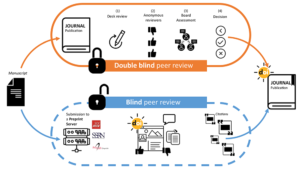By Luiz Augusto Campos
In 2020, DADOS began accepting the submission of manuscripts from preprint servers. However, there are still many concerns from the academic community, especially in the Social Sciences, about what preprints are and what changes they bring to the traditional framework of scientific assessment and publication. Our goal here is to answer these questions briefly, in addition to explaining in a simple way how to submit a preprint to DADOS. To this end, we have prepared a schematic of how manuscripts are evaluated in the traditional double-blind review system and how it has been modified in the preprint model. Next, we have a video and a podcast episode (both available in Portuguese only) about how DADOS will incorporate preprints, followed by a text summarizing this material.
[VIDEO]
[PODCAST]
The double-blind peer review system
Traditionally, manuscripts submitted to an academic journal go through double-blind peer review, in which neither the authors nor the reviewers are aware of each other’s identities. In this model, manuscripts go through four major editorial screenings:
- Desk review: the formal review or desk review is a technical analysis of the paper according to the journal’s criteria, which include the norms of citation, consistency with the thematic scope of the journal, the grammatical quality of the text etc.
- Double-blind peer review: if the article passes the first screening, it goes on to anonymous peer review. What characterizes this model is that neither reviewers nor authors know each other’s identity, hence the double-blind label. The premise here is that anonymity would allow for a more impartial judgment of academic articles.
- Board Assessment: with the assistance of the editorial board, the Editor-in-Chief assesses the relevance of the reviews and the article itself.
- Decision: if the text passes through the scrutiny of the reviewers and evaluation of the board, its publication is evaluated by the editor, who makes the final decision.
Once published, the text receives a digital object identifier (DOI), a numerical code from which the article can be virtually accessed and cited by other publications. This helps authors to publicize their work and the journal to increase its academic impact, something that can be measured with metrics such as the Impact Factor or other indexes.
Still hegemonic in the publishing world, however, this system has some issues. In the Social Sciences, an article takes an average of one to three years between submission and its final publication, especially for the time required for peer review by anonymous reviewers. It is worth noting that this work is not paid, which ends up relegating the drafting of reviews a low priority in their lists. Another problem with this model is the fact that the entire editorial process runs in secret, as only the Editor-in-Chief and perhaps the editorial team know who is involved and what they are writing each other.
What changes with preprint submission?
The preprint system was created with the intention of overcoming the issues of the double-blind peer review model. Roughly speaking, it operates opposite to the double-blind review system by opening the authorship information of the papers even before their assessment. In DADOS, it works as follows:
- Double submission: while an author submits an article to the journal, it can be deposited on a preprint server. There are several servers, each one with its own specificities. But they all are repositories of preliminary academic texts. Preprint servers are fully open and function as a social network, in which the manuscripts can be modified, commented, and evaluated by any interested person.
- DOI in the beginning of the process: as the article becomes available as a preprint, it receives a DOI, immediately allowing citation in other academic publications. Another difference of preprints submission is that authors can produce different versions of the same text and all are made public and accessible.
- Blind review: although the journal’s evaluation runs parallel, it no longer occurs through the double-blind peer review system, as the identity of its authors will be available on the preprint server. For this reason, this evaluation system is single blind: only the authors don’t know reviewers’ identities. Therefore, the advent of preprints means that the assessment of scientific manuscripts has a side that is closed and secret and another side that is open and transparent.
The preprint system has many potentials in comparison to the traditional double-blind assessment model. The main one is, clearly, the immediate availability of the manuscript, which does not have to wait years to be disclosed to the academic community and the general public. The second potential advantage is the greater openness and transparency of academic debate to the public. Any interested person can comment or disclose the paper’s content. The third advantage regards the possibility of registering multiple versions of a manuscript in the same space. Such versions record the evolution of the article in the light of the comments it received, or even in relation to the research evolution.
However, the preprint system also presents risks. The main one has to do with the effects, still nebulous, of the substitution of the anonymous evaluation. Although authors remain unaware of the identity of their reviewers, they will now be able to access the authorship of the reviewed work. We do not know, therefore, whether this assessment will meet minimum parameters of scientific ethics or whether it will affect the impartiality of the assessment. It is possible that authors of subordinate groups, for example, are evaluated in a discriminatory way with the statement of their identities. Opening unreviewed manuscripts to the general public can also lead to the dissemination of misleading research results, something that has been happening, for example, regarding texts about COVID-19.
That is why DADOS chose not to compromise with one or another assessment system, relegating that choice to the authors. These are the ones who must state, at the time of submission, whether they wish to submit through the double-blind evaluation system or single blind simultaneously to making them available as preprints. In any case, DADOS encourages the community of authors to experiment with submission via preprints, without making submissions unfeasible through the traditional system to put the aforementioned potentials and limits to test. The complete instructions for submission can be read here. The journal and our editorial team are completely open to answering any questions about these changes.
External links
Instructions – Dados: http://dados.iesp.uerj.br/en/instrucoes/
About Luiz Augusto Campos
Luiz Augusto Campos is a professor of Sociology and Political Science at the Instituto de Estudos Sociais e Políticos of Universidade do Estado do Rio de Janeiro (IESP-UERJ) and PhD in Sociology by the same institute. He is Editor-in-Chief of journal DADOS and participates in the coordination of two research groups: the Grupo de Estudos Multidisciplinares da Ação Afirmativa (GEMAA) and the Observatório das Ciências Sociais (OCS). He works in research on race and politics, text analysis and scientometrics.
Original article in Portuguese
http://dados.iesp.uerj.br/o-que-sao-preprints/
Translated from the original in Portuguese by Lilian Nassi-Calò.
Como citar este post [ISO 690/2010]:





![Is the Bill and Melinda Gates Foundation’s new OA policy the start of a shift towards preprints? [Originally published in the LSE Impact blog in April/2024] Preprints-LSE-Impact_thumb](https://blog.scielo.org/en/wp-content/uploads/sites/2/2024/04/Preprints-LSE-Impact_thumb.png)
![Funders support use of reviewed preprints in research assessment [Originally published by eLife in December/2022] eLife logo](https://blog.scielo.org/en/wp-content/uploads/sites/2/2022/11/eLife-logo_thumb.jpg)
![Some remarks on peer review and preprints [Originally published as the editorial in Memórias do Instituto Oswaldo Cruz vol. 118] Montage. Photo of a data center, a corridor with machines occupying the wall and processing computer systems. In front, a vector illustration of a microscope and a cross behind. A braided circle around the two. At the top, the logo of the journal Memórias do Instituto Oswaldo Cruz. At the bottom, the text: Peer Review x Preprint.](https://blog.scielo.org/en/wp-content/uploads/sites/2/2023/07/mioc-thumb.png)
![Large Language Publishing [Originally published in the Upstream blog in January/2024] Superimposed photograph of several books with the pages folded into an airplane shape on an infinite black background.](https://blog.scielo.org/en/wp-content/uploads/sites/2/2024/01/pexels-viktor-talashuk-2377295_thumb.jpg)
![Where to start with AI in research management [Originally published in the LSE Impact blog in December/2024] Image generated by Google DeepMind. The image has a purple background and you can read “How do large language models work?” with a brief description below.](https://blog.scielo.org/en/wp-content/uploads/sites/2/2024/12/AI-Research-Magagement-LSE-Impact-1-150x150.jpg)








Recent Comments